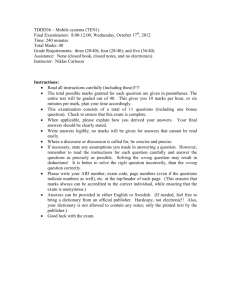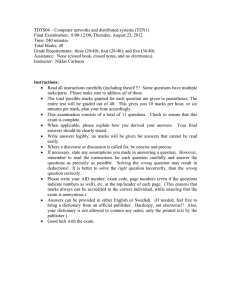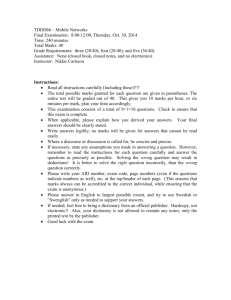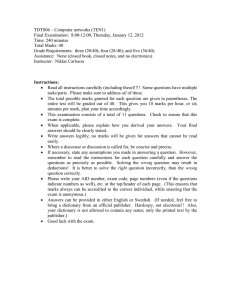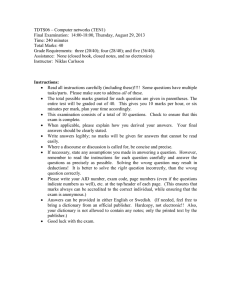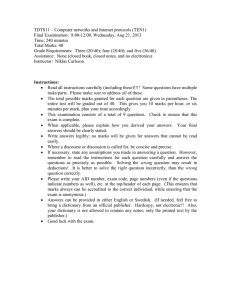CMPT 330 - Systems Programming
advertisement
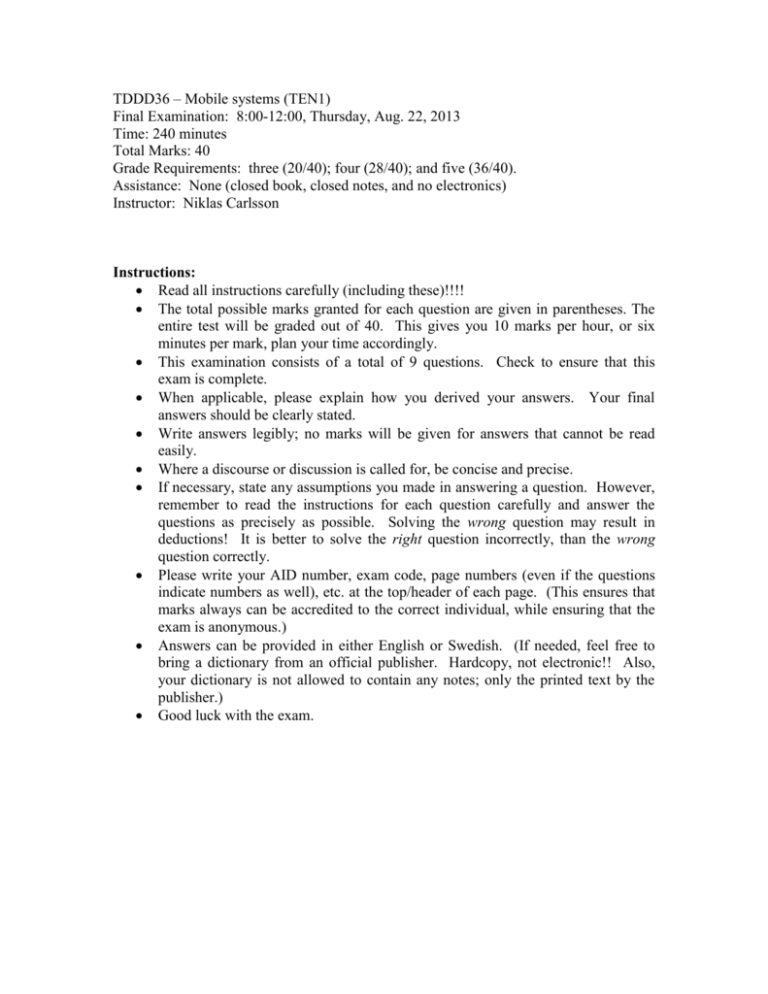
TDDD36 – Mobile systems (TEN1) Final Examination: 8:00-12:00, Thursday, Aug. 22, 2013 Time: 240 minutes Total Marks: 40 Grade Requirements: three (20/40); four (28/40); and five (36/40). Assistance: None (closed book, closed notes, and no electronics) Instructor: Niklas Carlsson Instructions: Read all instructions carefully (including these)!!!! The total possible marks granted for each question are given in parentheses. The entire test will be graded out of 40. This gives you 10 marks per hour, or six minutes per mark, plan your time accordingly. This examination consists of a total of 9 questions. Check to ensure that this exam is complete. When applicable, please explain how you derived your answers. Your final answers should be clearly stated. Write answers legibly; no marks will be given for answers that cannot be read easily. Where a discourse or discussion is called for, be concise and precise. If necessary, state any assumptions you made in answering a question. However, remember to read the instructions for each question carefully and answer the questions as precisely as possible. Solving the wrong question may result in deductions! It is better to solve the right question incorrectly, than the wrong question correctly. Please write your AID number, exam code, page numbers (even if the questions indicate numbers as well), etc. at the top/header of each page. (This ensures that marks always can be accredited to the correct individual, while ensuring that the exam is anonymous.) Answers can be provided in either English or Swedish. (If needed, feel free to bring a dictionary from an official publisher. Hardcopy, not electronic!! Also, your dictionary is not allowed to contain any notes; only the printed text by the publisher.) Good luck with the exam. TDDD36/TEN1 – Mobile systems Final Exam: 8:00-12:00, Thursday, August 22, 2013 1) Question: Encapsulation (6) Show the link-layer frame for a request for a small Web page that fits in a single frame (i) when it arrives to the link layer at the mobile client using 802.11, and (ii) when it arrives at the link layer of the Web server. You do not have to show all the details of the different headers; however, you should (i) explain what protocols the different headers are associated with, and (ii) provide the address information associated with the source and destination fields for each of the different headers. You can assume that the client machine uses 802.11, have a MAC address AA:AA:AA:BB:BB:BB and an IP address 111.222.111.222. The closest router has three interfaces, with the interface closest to the client having MAC and IP addresses BB:BB:BB:CC:CC:CC and 111.222.111.133, and the interface on the path to/from the server having MAC and IP addresses BB:BB:BB:DD:DD:DD and 111.222.111.144. The MAC addresses of the access point that the client is associated is AA:AA:AA:CC:CC:CC. Finally, the MAC and IP addresses of the HTTP server are CC:CC:CC:AA:AA:AA and 222.222.222.222. (Note: As explained on the cover page, if the necessary address information is not explicitly provided in the question, you are expected to make reasonable assumptions, and carefully motivate these assumptions.) 2) Question: 802.11 (4) The 802.11 protocol can handle some hidden-terminal problems using the RTS-CTS mechanism. Please explain the following: (a) What is the hidden-terminal problem? When and how does it occur? (b) How does the RTS-CTS mechanism help towards solving the hidden-terminal problem? Please illustrate with the communication sequence when two nodes A and C both want to communicate with an intermediate node B. 3) Question: Roaming and energy (4) In the context of roaming between 802.11 access points, for example, please explain the difference between active and passive scanning? Please discuss potential energy tradeoffs in this scenario. 4) Question: Routing (4) Explain and illustrate how indirect routing is done in the context of mobile IP. 5) Question: Routing (4) Describe the main characteristics and operation of table-driven and on-demand-based routing approaches, respectively. (Please feel free to make use of example protocols when describing these two classes of protocols.) Also, list and describe the most significant advantages and disadvantages with each of the two approaches. 2 TDDD36/TEN1 – Mobile systems Final Exam: 8:00-12:00, Thursday, August 22, 2013 6) Question: Power save mode (4) Illustrate and explain how the power save mode (e.g., in 802.11) can be used to save energy of the mobile nodes. In the context of 802.11, what is the role of the access point? Also, sketch and explain the tradeoffs between latency, energy, and buffer size at the access point. 7) Question: Packet losses (4 + 4) Please consider a mobile client in Sweden watching video from a Website in the US. Assume that the last link (closest to the user) is wireless and has a high loss rate. Consider two scenarios. In the first scenario UDP is used at the transport layer and in the second TCP is used in the transport layer. Part a: For each of the two scenarios, compare and discuss the end-to-end efficiency (throughput, jitter, etc.) if the MAC protocol at the wireless link is implemented (i) with or (ii) without retransmissions. A figure or table illustrating/comparing delays and loss rates may help here. Please clearly state any additional assumptions. Part b: For each of the two scenarios, please discuss the potential advantage/disadvantage of using interleaving at the application. Also, please show how interleaving can help improve the user perceived experience. 8) Question: Streaming (2) Why is HTTP and TCP typically used for video streaming? 9) HTTP-based Adaptive Streaming (4) In mobile environments, the network conditions experienced by a client may vary significantly over the duration of a session. In this context, please explain what the main difference between typical (non-adaptive) HTTP-based streaming (as used by YouTube, for example) and HTTP-based adaptive streaming. Your answer should be supported with a head-to-head comparison of the behavior of two players (one of each type!) under a simple scenario with varying bandwidth availability. Your answer should involve reasonable assumptions, and should clearly show the buffer occupancy and video playback quality as a function of time (using appropriate figures/graphs, for example). Good luck! 3
